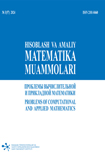Numerical calculation of turbulent flow in a channel with an obstacle based on COMSOL Multiphysics
Keywords:
mathematical modeling, turbulence models, Reynolds-averaged Navier- Stokes equations, models and k − e SSTAbstract
The paper presents the problem of numerical calculation of turbulent flow in a channel with an obstacle based on the COMSOL MULTIPHYSICS software package. Turbulent flow in a channel with an obstacle is a complex physical process that can be studied using numerical simulations, including the use of software packages such as COMSOL Multiphysics. Turbulence in a channel flow with an obstacle is characterized by vortex structures, three-dimensional motion and significant drag caused by the interaction of the flow with the obstacle. To simulate such a flow, various turbulence models can be used, such as the k−e model, the k−w model or the LES (large eddy method) models, as well as turbulence models based on the Reynolds equations (RANS). COMSOL Multiphysics provides the ability to simulate turbulent flow in a channel with an obstacle. The user can create channel geometry, add obstacles, set boundary conditions, select an appropriate turbulence model, and run flow simulations. As a result of modeling, it is possible to obtain data on speed, pressure, turbulent parameters and other characteristics of the flow. These data allow a deeper understanding of the physical process of real flow in a channel with an obstacle, as well as optimization of the design to improve flow characteristics. In the numerical calculation of turbulent flow in the channel, standard k−e and SST models were used. The results obtained using the COMSOL MULTIPHYSICS package were compared with experimental data.
References
Tu J. A Beginning Computational Fluid Dynamics : a practical approach. – 2018. – 367 p.
Александрова Т.Н., Арустамян К.М., Романенко С.А. Применение математических методов анализа при оценке мировой практики селективной флотации медно-цинковых и колчеданно-полиметаллических руд // Обогащение руд. – 2017. – №5. – С. 21-27.
Abgrall R., Saurel R. Discrete equations for physical and numerical compressible multiphase mixtures // Journal of Computational Physics. – 2003. – Vol. 186. – Issue 2.
Belotserkovskii O.M. Numerical Methods in Fluid Dynamics. — Hemisphere Pub. Corp, 1978. – 339 p.
Годунов С.К. Разностный метод численного расчета разрывных решений уравнений гидродинамики // Математический сборник. – 1959. — Т. 47, № 3. – С. 271-306.
Jang C.B., Choi S.W., Baek J.B. CFD modeling and fire damage analysis of jet fire on hydrogen pipeline in a pipe rack structure // International Journal of Hydrogen Energy. – 2015. — Vol. 40, Issue 45.
Darema F. A single-program-multiple-data computational model for EPEX/FORTRAN Parallel Computing. – 1988. – Vol. 7, Issue 1.
Spalart P.R., Allmaras S.R. A one-equation turbulence model for aerodynamic flow // AIAA Paper. – 1992. – Vol. 12. – P. 439-478.
Shur M.L, Strelets M.K., Travin A.K., Spalart P.R. Turbulence modeling in rotating and curved channels: Assessing the Spalart-Shur correction // AIAA Journal. – 2000. – Vol. 38.– P. 784-792.
Mentor F.R. Turbulence Models with Two Equations for Engineering Applications // AIAA Journal. – 1994. – Vol. 32, No. 8. – P. 1598-1605.
Johnson F.T., Tinoco E.N., Yu N.J. Thirty years of development and application of CFD at Boeing Commercial Airplanes, Seattle // Computers & Fluids. – 2005. – Vol. 34, No. 10. - P. 1115-1151.
Leifsson L., Koziel S. Aerodynamic shape optimization by variable-fidelity computational fluid dynamics models: A review of recent progress // Journal of Computational Science. –2015. – Vol. 10. – P. 45-54.
Aksenov A., Dyadkin A., Pokhilko V. Overcoming of barrier between CAD and CFD by modified finite volume method // ASME Publications PVP. – 1998. – Vol. 377. – P. 79-83.
Wilcox D.C. Turbulence modeling for CFD. – DCW Industries Inc., 1994.
Потемкин В.А., Хасенов А.М., Потапов С.Д. Применение методов вычислительной гидродинамики при моделировании реологических свойств суспензий в процессах переработки минерального и углеводородного сырья // Научный аспект. – 2018.– №4. - С. 811-818.
Маликов З.М., Назаров Ф.Х. Математическое моделирование и численное исследование переноса твердых частиц в воздушном классификаторе // Проблемы вычислительной и прикладной математики. – 2017.– №5. – С. 47-49.
Malikov Z.M., Nazarov F.Kh. Study of turbulence models for calculating a strongly swirling flow in an abrupt expanding channel // Computer Research and Modeling. – 2021. – Vol. 13, Issue 4. – P. 793-805.
Маликов З.М., Назаров Ф.Х., Мадалиев М.Э. Численное моделирование обтекания плоской пластины турбулентным потоком воздуха с нулевым градиентом давления на основе ???? −???? моделей // Проблемы вычислительной и прикладной математики. – 1992. – №4. – С. 33-40.
Маликов З.М., Назаров Ф.Х., Мадалиев М.Э. Применение модифицированной ???? − ???? модели для исследования затопленной осесимметричной турбулентной струи // Проблемы вычислительной и прикладной математики. – 2019. – №34. – С. 87-93.
Nazarov F.Kh., Khasanov S.M., Yakubov A.A. Computational experiment of swirling flows of turbulence models SA and SST // International Journal of Recent Technology and Engineering. – 2019. – Vol. 8, Issue 4. – P. 2140-2144.
Маликов З.М., Назаров Ф.Х., Мадалиев М.Э. Сравнение современных моделей турбулентности для течения Тейлора-Куэтта // Вестник Томского государственного университета. Математика и механика. – 2022. – №78. – С. 125-142.
Larsen P.S., Westergaard C.H., Koch C.W. Experimental and numerical Study of fence – on – wall case // Month intermediate report of AFM Technical University of Denmark. –2019. – Vol. 8, Issue 4.– P. 2140-2144.
Aleksandrova T.N., Romashev A.O., Aleksandrov A.V. About modeling of rheological properties of heavy oil suspensions // Oil Industry. – 2016. – Vol. 5, Issue 4. – P. 68-70.
Мадалиев М.Э. и др. Численное Исследование Модифицированного Центробежного Циклона // Central Asian Journal Of Mathematical Theory And Computer Sciences. –2022.– Vol. 3, Issue 4. – С. 123-132.





